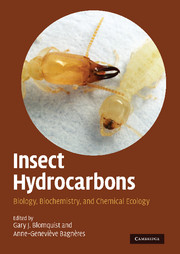Crossref Citations
This Book has been
cited by the following publications. This list is generated based on data provided by Crossref.
2010.
Books and Monographs Received.
Ecology,
Vol. 91,
Issue. 9,
p.
2809.
Lizé, Anne
Cortesero, Anne Marie
Bagnères, Anne-Geneviève
and
Poinsot, Denis
2010.
Kin recognition in the larvae of a solitary insect: the cue is in the plug.
Behavioral Ecology,
Vol. 21,
Issue. 3,
p.
633.
Bonasio, Roberto
Zhang, Guojie
Ye, Chaoyang
Mutti, Navdeep S.
Fang, Xiaodong
Qin, Nan
Donahue, Greg
Yang, Pengcheng
Li, Qiye
Li, Cai
Zhang, Pei
Huang, Zhiyong
Berger, Shelley L.
Reinberg, Danny
Wang, Jun
and
Liebig, Jürgen
2010.
Genomic Comparison of the Ants
Camponotus floridanus
and
Harpegnathos saltator
.
Science,
Vol. 329,
Issue. 5995,
p.
1068.
Perdereau, Elfie
Dedeine, Franck
Christidès, Jean-Philippe
and
Bagnères, Anne-Geneviève
2010.
Variations in Worker Cuticular Hydrocarbons and Soldier Isoprenoid Defensive Secretions Within and Among Introduced and Native Populations of the Subterranean Termite, Reticulitermes flavipes.
Journal of Chemical Ecology,
Vol. 36,
Issue. 11,
p.
1189.
Darrouzet, Eric
Lebreton, Sébastien
Gouix, Nicolas
Wipf, Aurore
and
Bagnères, Anne-Geneviève
2010.
Parasitoids Modify Their Oviposition Behavior According to the Sexual Origin of Conspecific Cuticular Hydrocarbon Traces.
Journal of Chemical Ecology,
Vol. 36,
Issue. 10,
p.
1092.
Meunier, Joël
Delémont, Olivier
Lucas, Christophe
and
Gursky-Doyen, Sharon
2011.
Recognition in Ants: Social Origin Matters.
PLoS ONE,
Vol. 6,
Issue. 5,
p.
e19347.
Niehuis, O
Büllesbach, J
Judson, A K
Schmitt, T
and
Gadau, J
2011.
Genetics of cuticular hydrocarbon differences between males of the parasitoid wasps Nasonia giraulti and Nasonia vitripennis.
Heredity,
Vol. 107,
Issue. 1,
p.
61.
Ruther, Joachim
Döring, Mathias
and
Steiner, Sven
2011.
Cuticular hydrocarbons as contact sex pheromone in the parasitoid Dibrachys cavus.
Entomologia Experimentalis et Applicata,
Vol. 140,
Issue. 1,
p.
59.
Geiselhardt, Stefanie F.
Geiselhardt, Sven
and
Peschke, Klaus
2011.
Congruence of epicuticular hydrocarbons and tarsal secretions as a principle in beetles.
Chemoecology,
Vol. 21,
Issue. 3,
p.
181.
Thomas, Melissa L.
and
Simmons, Leigh W.
2011.
Short-term phenotypic plasticity in long-chain cuticular hydrocarbons.
Proceedings of the Royal Society B: Biological Sciences,
Vol. 278,
Issue. 1721,
p.
3123.
Perdereau, E.
Dedeine, F.
Christidès, J.-P.
Dupont, S.
and
Bagnères, A.-G.
2011.
Competition between invasive and indigenous species: an insular case study of subterranean termites.
Biological Invasions,
Vol. 13,
Issue. 6,
p.
1457.
Meunier, Joël
2011.
Can alternative pathways mediate the influence of queen number on nestmate discrimination in ants?.
Communicative & Integrative Biology,
Vol. 4,
Issue. 5,
p.
609.
Ranganathan, Yuvaraj
and
Borges, Renee M.
2011.
To transform or not to transform.
Plant Signaling & Behavior,
Vol. 6,
Issue. 1,
p.
113.
Martin, Stephen J.
Helanterä, Heikki
and
Drijfhout, Falko P.
2011.
Is parasite pressure a driver of chemical cue diversity in ants?.
Proceedings of the Royal Society B: Biological Sciences,
Vol. 278,
Issue. 1705,
p.
496.
von Beeren, Christoph
Schulz, Stefan
Hashim, Rosli
and
Witte, Volker
2011.
Acquisition of chemical recognition cues facilitates integration into ant societies.
BMC Ecology,
Vol. 11,
Issue. 1,
2011.
Ecology and Evolution of Dung Beetles.
p.
293.
Wurm, Yannick
Wang, John
Riba-Grognuz, Oksana
Corona, Miguel
Nygaard, Sanne
Hunt, Brendan G.
Ingram, Krista K.
Falquet, Laurent
Nipitwattanaphon, Mingkwan
Gotzek, Dietrich
Dijkstra, Michiel B.
Oettler, Jan
Comtesse, Fabien
Shih, Cheng-Jen
Wu, Wen-Jer
Yang, Chin-Cheng
Thomas, Jerome
Beaudoing, Emmanuel
Pradervand, Sylvain
Flegel, Volker
Cook, Erin D.
Fabbretti, Roberto
Stockinger, Heinz
Long, Li
Farmerie, William G.
Oakey, Jane
Boomsma, Jacobus J.
Pamilo, Pekka
Yi, Soojin V.
Heinze, Jürgen
Goodisman, Michael A. D.
Farinelli, Laurent
Harshman, Keith
Hulo, Nicolas
Cerutti, Lorenzo
Xenarios, Ioannis
Shoemaker, DeWayne
and
Keller, Laurent
2011.
The genome of the fire ant
Solenopsis invicta
.
Proceedings of the National Academy of Sciences,
Vol. 108,
Issue. 14,
p.
5679.
BONCKAERT, W.
Van ZWEDEN, J. S.
D’ETTORRE, P.
BILLEN, J.
and
WENSELEERS, T.
2011.
Colony stage and not facultative policing explains pattern of worker reproduction in the Saxon wasp.
Molecular Ecology,
Vol. 20,
Issue. 16,
p.
3455.
Tabadkani, Seyed Mohammad
Nozari, Jamasb
and
Lihoreau, Mathieu
2012.
Inbreeding and the evolution of sociality in arthropods.
Naturwissenschaften,
Vol. 99,
Issue. 10,
p.
779.
Nielsen, Mattias Lange
and
Holman, Luke
2012.
Terminal investment in multiple sexual signals: immune‐challenged males produce more attractive pheromones.
Functional Ecology,
Vol. 26,
Issue. 1,
p.
20.



